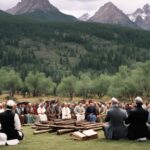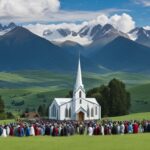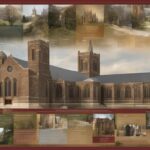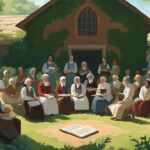Welcome to our comprehensive exploration of the history and key aspects of the Mormon Church, officially known as the Church of Jesus Christ of Latter-day Saints. In this article, we will delve into the origins and founders, key beliefs and doctrines, historical significance, denominational split, leadership and governance, worship practices, contemporary influence, as well as the current world membership number and percentage of world religions.
Key Takeaways:
- The Mormon Church, founded by Joseph Smith in the early 19th century, has a rich and fascinating history.
- Key beliefs and doctrines of the Mormon Church include continuing revelation, baptism for the dead, eternal marriage and families, and the potential for humans to become gods in the afterlife.
- The Mormon Church played a significant role in the westward expansion of the United States and has faced persecution throughout history.
- There have been denominational splits within the Mormon Church, resulting in the formation of various sects with their own beliefs and practices.
- The Mormon Church is led by a hierarchical structure with the President of the Church as the highest authority, who is believed to receive ongoing revelation.
Origins and Founders of the Mormon Church
The Mormon Church, officially known as the Church of Jesus Christ of Latter-day Saints (LDS Church), traces its origins back to the early 19th century. The church was founded by Joseph Smith, a farm boy from New England, who claimed to have had visions and revelations from God. One of the most significant events in the church’s history was Smith’s translation of ancient golden plates, which became known as the Book of Mormon. This sacred text serves as an additional testament of Jesus Christ, complementing the Bible.
The teachings and revelations received by Joseph Smith formed the foundation of the Mormon Church. Smith believed in the restoration of Jesus Christ’s original church and priesthood authority. He organized the LDS Church in 1830, with himself as the first prophet and president. Smith’s leadership and the introduction of unique doctrines and practices attracted a dedicated following.
Under Smith’s guidance, the Mormon Church experienced rapid growth, but it also faced persecution and opposition from various quarters. Ultimately, Smith was martyred in 1844, leading to a period of succession crises within the church. Brigham Young emerged as the new leader and led the Mormon pioneers to settle in what is now Utah. His leadership played a pivotal role in the establishment and expansion of the church in the American West.
Table: Key Founders of the Mormon Church
| Name | Role |
|---|---|
| Joseph Smith | Founder, Prophet, and First President |
| Brigham Young | Second President and Leader of the Mormon Pioneers |
| Hyrum Smith | Brother of Joseph Smith and Church Leader |
| Emma Smith | Wife of Joseph Smith and First President of the Relief Society |
The origins and founders of the Mormon Church, particularly Joseph Smith and Brigham Young, played crucial roles in shaping its early development. Their visions, leadership, and dedication laid the groundwork for the unique beliefs, doctrines, and practices that continue to define the LDS Church today.
Key Beliefs and Doctrines of the Mormon Church
The Mormon Church, officially known as the Church of Jesus Christ of Latter-day Saints (LDS Church), has a rich set of beliefs and doctrines that distinguish it from other Christian denominations. These beliefs are rooted in the teachings of Joseph Smith, the founder of the Mormon Church, and are considered essential for members of the church to follow and adhere to.
Mormon Belief 1: Continuing Revelation
One key belief of the Mormon Church is the concept of continuing revelation. Mormons believe that God has not only spoken to His prophets in ancient times but continues to communicate with them in the present day. The President of the Church, who is believed to be a prophet, seer, and revelator, receives ongoing revelation for the church and its members. This belief in continuing revelation allows for the adaptation of doctrine over time as new guidance is received.
Mormon Belief 2: Baptism for the Dead
Another unique belief of the Mormon Church is the practice of baptism for the dead. Mormons believe that baptism is necessary for salvation and that those who have died without the opportunity to be baptized can receive this ordinance vicariously by living members of the church. This belief stems from the belief in the importance of family and the eternal nature of relationships.
Mormon Belief 3: Eternal Marriage and Families
The Mormon Church places a strong emphasis on the importance of marriage and family. Mormons believe that marriage can be eternal and that families can be sealed together for eternity through sacred temple ordinances. This belief in eternal marriage and families shapes the way Mormons approach relationships and prioritize the well-being of their families.
Mormon Belief 4: Potential for Humans to Become Gods
One of the most distinctive beliefs of the Mormon Church is the belief in the potential for humans to become gods in the afterlife. Mormons believe that through obedience to God’s commandments and following the teachings of Jesus Christ, individuals can progress spiritually and eventually attain godhood. This belief reflects the Mormon emphasis on personal growth and eternal progression.
Mormon Belief 5: Other Doctrines and Practices
In addition to these key beliefs, the Mormon Church also has other unique doctrines and practices. These include the belief in the pre-mortal existence of spirits, the importance of missionary work to spread the teachings of the church, and the practice of tithing, where members contribute 10% of their income to support the church. The combination of these beliefs and practices creates a distinct religious identity for members of the Mormon Church.
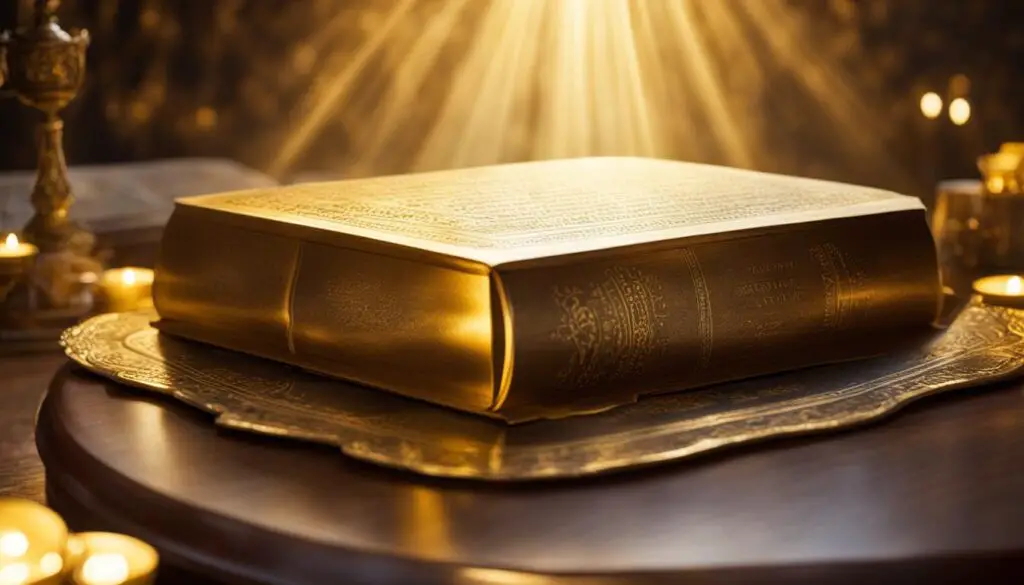
| Key Beliefs | Description |
|---|---|
| Continuing Revelation | Mormons believe that God continues to communicate with His prophets in the present day. |
| Baptism for the Dead | Mormons practice baptism on behalf of deceased individuals who did not have the opportunity to be baptized in their lifetime. |
| Eternal Marriage and Families | Mormons believe that marriage can be eternal and that families can be sealed together for eternity. |
| Potential for Humans to Become Gods | Mormons believe that individuals have the potential to become gods in the afterlife through obedience to God’s commandments. |
Historical Significance of the Mormon Church
The Mormon Church, also known as the Church of Jesus Christ of Latter-day Saints (LDS Church), has played a significant role in the history of the United States. One of the pivotal moments in Mormon history was the westward expansion and settlement of Utah by the Mormon pioneers.
“This is the right place.” – Brigham Young
Brigham Young, the successor of Joseph Smith, led the Mormon pioneers to Utah in 1847. Under his leadership, the Mormons established a thriving community, transforming the arid desert into a prosperous and self-sustaining society. They built cities, constructed irrigation systems, and established an economic and political foothold in the region.
However, the Mormons faced persecution and hostility from non-Mormon settlers and the federal government. This tension culminated in the “Mormon War” in the late 1850s, as well as the enactment of anti-polygamy laws. Ultimately, the church officially renounced the practice of polygamy in 1890, leading to the resolution of conflicts with the government and the end of the “Mormon War.”
| Year | Event |
|---|---|
| 1847 | Brigham Young leads Mormon pioneers to settle in Utah |
| 1857-1858 | Mormon War |
| 1890 | Official end of polygamy within the LDS Church |
Denominational Split or Schisms in the Mormon Church
The Mormon Church has experienced several denominational splits throughout its history, leading to the formation of various breakaway groups with their own distinct beliefs and practices. One of the most significant schisms in the Mormon Church occurred in the late 19th century after the church officially renounced polygamy in 1890.
This decision caused a divide within the church, with some members and leaders refusing to abide by the new policy. As a result, several splinter groups emerged, each claiming to be the true continuation of Joseph Smith’s original teachings and practices. These breakaway sects include the Fundamentalist Church of Jesus Christ of Latter-Day Saints (FLDS) and the Apostolic United Brethren (AUB), among others.
The denominational split was not only a result of differing beliefs on polygamy but also disagreements on other doctrines and leadership succession. Some groups believed that the LDS Church had strayed from the original teachings of Joseph Smith, necessitating the formation of new sects to preserve what they saw as the true Mormon faith.
“The schisms within the Mormon Church reflect the ongoing tensions between tradition and modernity, as well as divergent interpretations of scripture and religious authority,” says religious historian Thomas Evans. “While the LDS Church represents the largest and most well-known branch of Mormonism, these breakaway groups offer alternative paths for those seeking a more conservative interpretation of Mormon doctrine.”
Table: Overview of Breakaway Mormon Sects
| Sect Name | Beliefs | Membership Size | Current Leader(s) |
|---|---|---|---|
| Fundamentalist Church of Jesus Christ of Latter-Day Saints (FLDS) | Belief in the continued practice of polygamy, strict adherence to early Mormon teachings | Estimated 10,000-20,000 members | Various leaders, including Warren Jeffs |
| Apostolic United Brethren (AUB) | Belief in plural marriage, emphasis on communal living and self-sufficiency | Estimated 10,000 members | Various leaders, including Lynn A. Thompson |
| Remnant Church of Jesus Christ of Latter Day Saints (RLDS) | Belief in the Book of Mormon and Joseph Smith’s prophetic role, rejection of polygamy | Estimated 3,000 members | Various leaders, including Frederick Niels Larsen |
Leadership and Governance in the Mormon Church
The Mormon Church, officially known as the Church of Jesus Christ of Latter-day Saints (LDS Church), operates under a hierarchical structure with the President of the Church serving as the highest authority. This leadership position is considered to be held by a prophet, seer, and revelator, who is believed to receive ongoing revelation for the church. The current President is Russell M. Nelson, who was ordained as the 17th President in 2018.
At various levels within the LDS Church, male members hold leadership positions. This is based on the church’s belief in the priesthood authority, which is considered to be the power and authority to act in the name of God. The priesthood is organized into different levels, including the Aaronic Priesthood and the Melchizedek Priesthood. These priesthood quorums and offices are responsible for carrying out various duties and responsibilities within the church.
The leadership and governance structure of the Mormon Church also includes a General Authority, which consists of individuals who hold key leadership positions and serve as advisors to the President of the Church. The General Authority is divided into several Quorums, including the Quorum of the Twelve Apostles, the Quorum of the Seventy, and the Presiding Bishopric. These leaders play a significant role in guiding the church’s policies, teachings, and administrative affairs.
Leadership Positions in the Mormon Church
The following table provides an overview of the key leadership positions within the Mormon Church:
| Leadership Position | Responsibilities |
|---|---|
| President of the Church | Serves as the highest authority and receives ongoing revelation for the church. |
| Quorum of the Twelve Apostles | Consists of 12 apostles who are considered special witnesses of Jesus Christ. |
| Quorum of the Seventy | Consists of general authorities who assist in the governance of the church. |
| Presiding Bishopric | Oversees the temporal and financial affairs of the church. |
| Aaronic Priesthood | Consists of young men who hold various offices and assist in the church’s ordinances and administration. |
| Melchizedek Priesthood | Consists of adult men who hold various offices and have greater responsibilities in the church’s leadership and ministry. |
The leadership and governance structure of the Mormon Church is designed to provide guidance, direction, and organization to its members. Through this system, the church aims to carry out its mission to spread the teachings of Jesus Christ and provide spiritual support to its members worldwide.
Worship Practices in the Mormon Church
The Mormon Church, also known as the Church of Jesus Christ of Latter-day Saints (LDS Church), has unique worship practices that are central to its religious teachings and community life. These practices provide opportunities for members to connect with God, strengthen their faith, and serve others.
Sunday Services and Sacrament Meetings
One of the core components of worship in the Mormon Church is the weekly Sunday service, also known as sacrament meeting. During this meeting, members gather to renew their covenants with God through the sacrament of bread and water, symbolizing the body and blood of Jesus Christ. It is a time for reflection, spiritual upliftment, and learning from sermons delivered by fellow members of the congregation.
Temple Ordinances and Rituals
In addition to Sunday services, the Mormon Church places great importance on temple worship. Temples are considered sacred spaces where special ordinances and rituals are performed, such as baptisms for the dead, eternal marriages, and other ordinances that unite families for eternity. These rituals are believed to be essential for the spiritual progression and salvation of both the living and the deceased.
Quote: “The temple is a place of peace, revelation, and connection with God. It is where we can feel closer to Him and receive personal revelation.” – Elder David A. Bednar
Focus on Family Involvement and Community Support
The Mormon Church emphasizes the importance of family involvement in worship and religious activities. Families are encouraged to pray together, study scriptures, and participate in service projects. The church also organizes various community events and initiatives to offer support to those in need, fostering a sense of unity and fellowship among its members.
| Worship Practices | Description |
|---|---|
| Sunday Services | Regular weekly meetings where members gather for worship and sermons. |
| Sacrament Meetings | Includes the ordinance of the sacrament, renewing covenants with God. |
| Temple Ordinances | Special rituals performed in temples, such as baptisms for the dead and eternal marriages. |
| Family Involvement | Encourages families to participate in religious activities and support one another. |
| Community Support | Organizes service projects and events to help those in need. |
These worship practices in the Mormon Church provide members with opportunities to deepen their spiritual connection, strengthen their families, and live out their religious beliefs in practical ways. Through regular worship and participation in these rituals, Mormons seek to align their lives with the teachings of Jesus Christ and build a relationship with God that extends beyond the walls of the church.
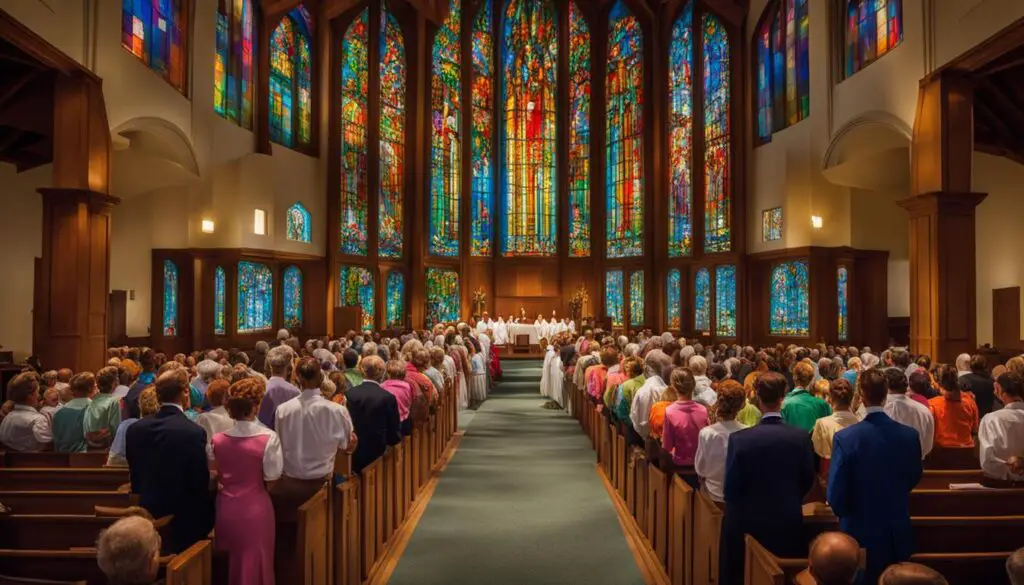
Contemporary Influence of the Mormon Church
The influence of the Mormon Church, officially known as the Church of Jesus Christ of Latter-day Saints (LDS Church), extends beyond its members to society at large. With a strong emphasis on family values, community service, and missionary work, the church has made a significant impact in various aspects of life.
In terms of family values, the LDS Church places a high importance on the institution of marriage and the stability of the family unit. Its teachings promote strong family relationships, parental involvement, and the nurturing of children. This emphasis on family has resonated with many individuals, influencing societal attitudes towards the importance of family bonds and commitments.
Community service is another area where the Mormon Church has had a notable influence. Its members are encouraged to engage in acts of service and charity, both within the church and in the wider community. The LDS Church operates numerous welfare programs and humanitarian efforts, providing assistance to those in need and fostering a culture of giving back.
Additionally, the church’s focus on missionary work has resulted in a global presence and a significant impact on spreading its beliefs and values. Young Mormons are encouraged to serve as missionaries, dedicating their time and efforts to sharing the teachings of the LDS Church with others around the world. This missionary work has not only contributed to the growth of the church but has also facilitated cross-cultural interactions and increased awareness of Mormonism in diverse communities.
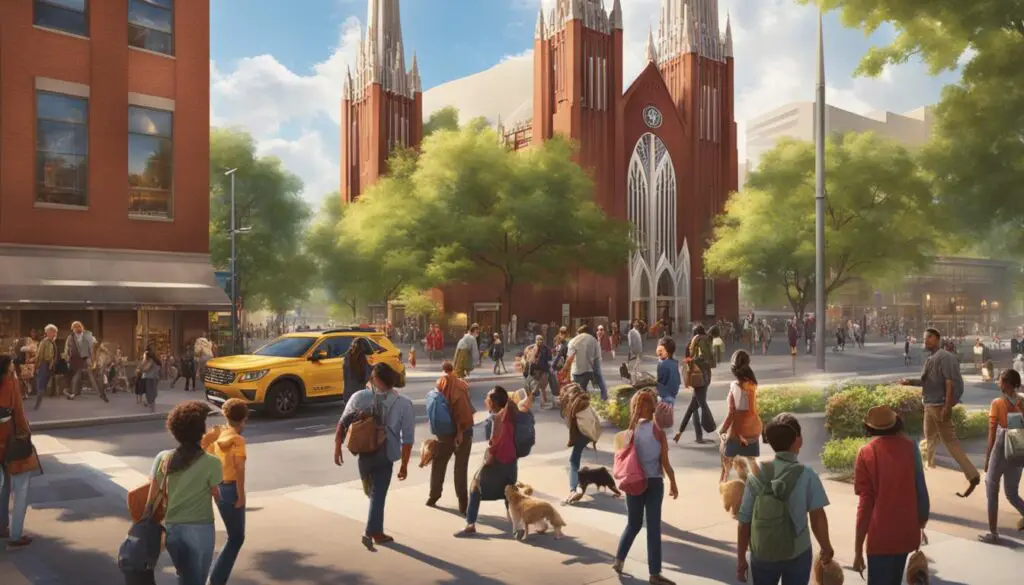
The Mormon Church in Politics
“We believe in being subject to kings, presidents, rulers, and magistrates, in obeying, honoring, and sustaining the law.” – Doctrine and Covenants 134:5
Another area where the influence of the Mormon Church is evident is in politics. The church’s teachings emphasize the importance of civic engagement and encouraging its members to be responsible citizens. This has led to the participation of many Mormons in political leadership positions, both at local and national levels. Prominent Mormon politicians have held positions of influence and have played a role in shaping public policies and agendas.
Overall, the contemporary influence of the Mormon Church can be seen in its impact on family values, community service, missionary work, and political participation. Through its teachings and actions, the LDS Church has shaped both its members and society, reflecting its core principles and commitment to making a positive difference in the world.
Current World Membership Number and Percentage of World Religions
The Church of Jesus Christ of Latter-day Saints, also known as the Mormon Church, has a current worldwide membership of over 16 million individuals. While this represents a relatively small percentage of the global population, approximately 0.2%, it is noteworthy that the church continues to experience steady growth.
The Mormon Church’s expansion can be seen not only in the United States but also in various countries around the world. Its missionary efforts and outreach programs have played a significant role in attracting new members and increasing the church’s global presence.
With its emphasis on family values, community service, and missionary work, the Mormon Church has had a profound influence on both its members and society at large. This influence extends beyond religious practices and into the political arena, with several prominent Mormon politicians and leaders holding positions in government.
As the Mormon Church continues to grow and evolve, its impact on the world is likely to expand as well. With a strong foundation of beliefs and a dedicated community, the church remains a vibrant and active presence in the modern world.
FAQ
When was the Mormon Church founded?
The Mormon Church, also known as the Church of Jesus Christ of Latter-day Saints (LDS), was founded in the early 19th century.
Who is the founder of the Mormon Church?
The founder of the Mormon Church is Joseph Smith.
What is the Book of Mormon?
The Book of Mormon is a religious text that Joseph Smith claimed to have translated from ancient golden plates.
What are some unique beliefs of the Mormon Church?
The Mormon Church believes in continuing revelation, baptism for the dead, eternal marriage and families, and the potential for humans to become gods in the afterlife.
What role did the Mormon Church play in the westward expansion of the United States?
The Mormons, led by Brigham Young, settled in Utah and established a thriving community. They also faced persecution and hostility, leading to the Mormon War and the end of polygamy within the church.
Has the Mormon Church experienced any schisms?
Yes, there have been several schisms in the Mormon Church, with breakaway groups forming their own sects after the official renouncement of polygamy in 1890.
How is the Mormon Church led and governed?
The Mormon Church is led by a hierarchical structure with the President of the Church as the highest authority. The church follows a system of priesthood authority, with male members holding various leadership positions.
What are some worship practices in the Mormon Church?
Worship in the Mormon Church includes weekly Sunday services, sacrament meetings, and other religious gatherings. The church also practices rituals such as baptism and confirmation, ordinations, temple ordinances, and the sacrament.
What contemporary influence does the Mormon Church have?
The Mormon Church is known for its emphasis on family values, community service, and missionary work. It also has a strong presence in politics, with several prominent Mormon politicians and leaders in government.
How many members does the Mormon Church have?
The Church of Jesus Christ of Latter-day Saints currently has over 16 million members worldwide.

